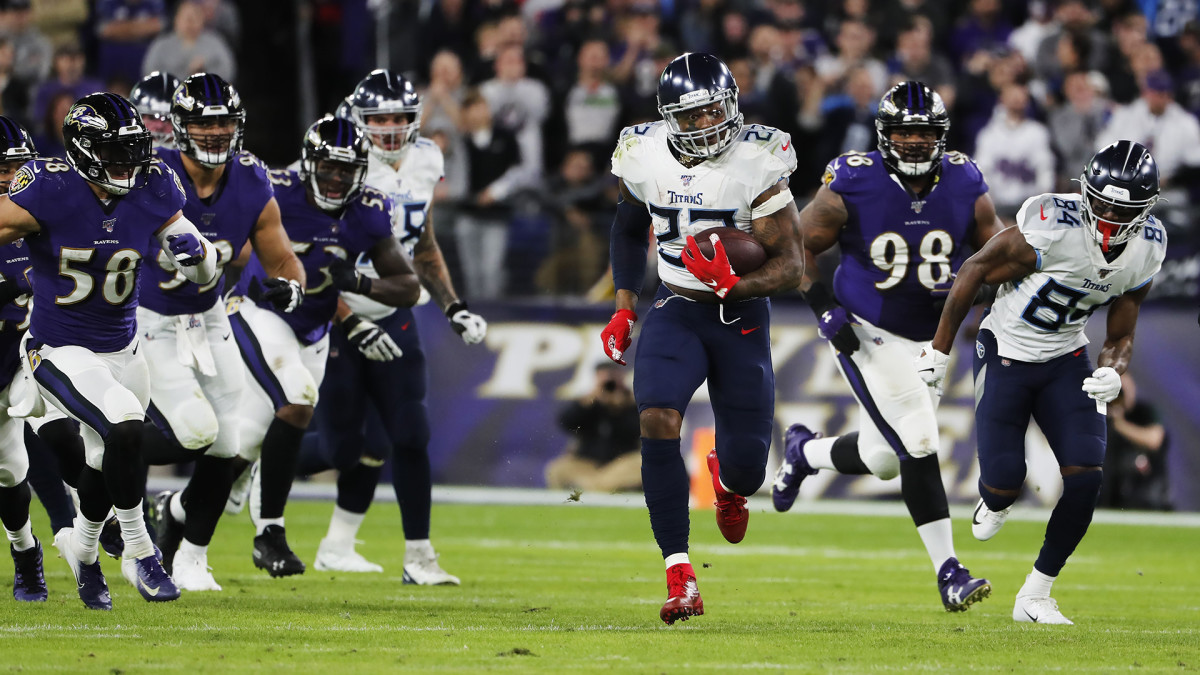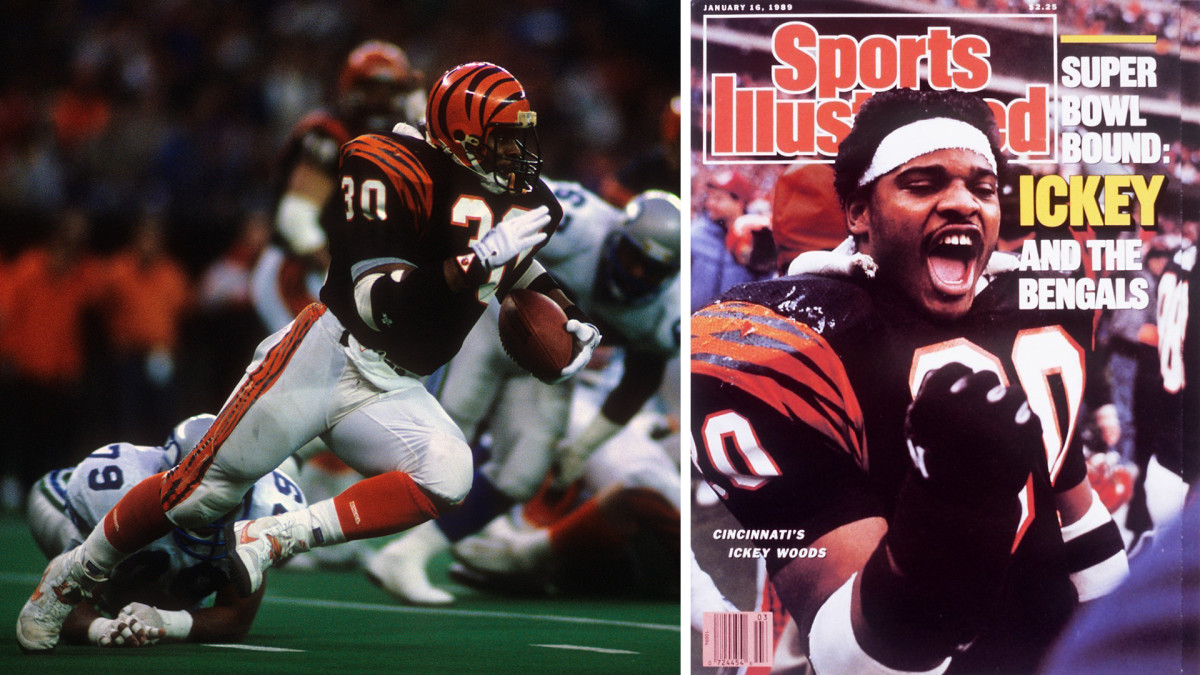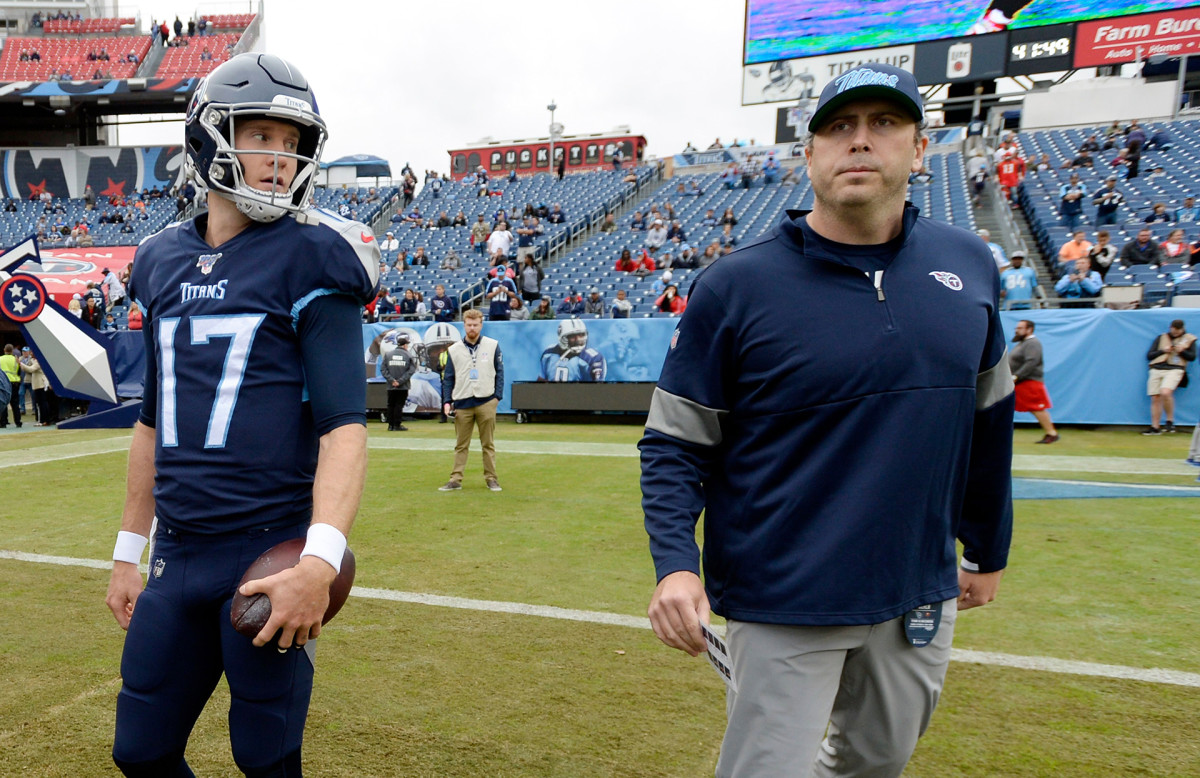How Derrick Henry and the Titans Ran Away From the Rest of the NFL

The godfather of wide zone football answers his cellphone and greets a stranger on the other end in a perfectly courteous Southern accent.
“I don’t know how much football you know, but I’ll assume you’re a good fan and you realize just basic premises,” he says, before launching right into an abridged version of a clinic that has been sought out by some of the most important names in the sport, from Urban Meyer and the Florida Gators to Sean Payton and the New Orleans Saints.
It won’t take long for Alex Gibbs, now 78 years old, to explain how we got to this moment in the 2019 NFL season, when the most dangerous nonquarterback remaining in the playoffs is a 6’ 3”, 240-pound running back who, despite reaching nearly 22 miles per hour at full sprint (at one point the fastest ball carrier in the NFL this season), has the slow-motion gait of a hobby jogger at your local public track and the body of a defensive end. Derrick Henry has rushed for 1,917 yards and 17 touchdowns this season. On average, every touch he makes nets more than five yards. More than 1,200 of those yards and 10 of those touchdowns have come from runs outside the tackle box.
On nearly 20 percent of the carries Henry takes outside of either of his tackles, he’s gaining more than 10 yards.

In short, if the original stewards of zone rushing were to have conjured a running back out of their wildest imagination to perfectly fit the most potent rushing scheme in football, they probably would have drawn up something similar to Henry. Likewise for a criminally underrated offensive line that paves his way. They work perfectly together in a scheme that Gibbs, a long-time offensive line coach, helped popularize as an answer to a question that had plagued him for years:
“No matter how you run the ball, the defense is going to collapse on you from both sides. So I said to myself, there has to be an easier way to do this outside of behemoths killing each other; cavalries charging straight into gunfire. I said there’s gotta be a better way to open up.”
And open up he did, by—get this—running away from the everyone else.
In an era of hypermodern offenses, Tennessee has laid the foundation for their deep playoff run in one of football’s most elemental principals. “Wide” or “outside” zone football, while employed by most teams as a slice of their offense, powers Tennessee’s attack, sets up a devastating suite of bootleg passes and, when combined with more contemporary presnap motion and movement, creates something truly maddening to stop. The rise of more athletic interior defensive linemen and practice restrictions for offensive linemen were thought to be the wide zone’s Achilles’ heel. Instead, the scheme, which most famously fueled two Super Bowl runs for Terrell Davis and the Denver Broncos in the late-1990s, could be used against Mike Shanahan’s own son, Kyle, if the 49ers and Titans happen to advance to the title game.
“That’s what they’re running, that’s the play that [Henry] runs,” says Gibbs (who referred to Henry alternately as “the big guy there” and “the massive human being.”) “Both ways, weak and strong. Every kind of motion. Every kind of formation and passes that look like they’re part of the run. They’re doing it well.”
* * *
Gibbs likes the word “puttering” and uses the relatively banal verb to describe the years of intense experimentation he’d gone through over nine jobs and 20 football seasons before his own hypotheses collided with a beautiful piece of running he unearthed on film.
A little more than 25 years ago, he stumbled upon some Bengals cutups from 1988—a breakthrough season when a rookie named Ickey Woods (6’ 2”, 235, and, according to Gibbs, a “humungous man”) finished ninth in rushing yards (1,066) and first in rushing touchdowns (15), and doing so with 185 fewer carries than that year’s rushing champion, Eric Dickerson. Woods led the league in yards per carry.
Cincinnati’s offensive line coach, Jim McNally, was overseeing a scheme that had Woods make a hard, directional sprint targeted five yards outside of the widest offensive lineman after receiving the handoff. By doing so, Woods more regularly avoided getting tackled by backside lineman—who couldn’t give chase laterally—solving what had long been Gibbs’s biggest curiosity: altering the straightforward, car-crash nature of most handoffs.
“That is the beginning, in my opinion,” he says. “I looked at that thing, saw that big Ickey Woods running so wide that the defense on the backside had no part of it.”

When Mike Shanahan entrusted Gibbs with developing the Broncos’ running game, Gibbs and the offensive staff adjusted McNally’s targets and settled on a hard sprint at the widest lineman, basically one yard outside of the tight end. The play accomplished a few things that flipped the advantage of a given running play toward the offense:
• By running downhill and to one side, a running back already builds up speed and momentum, so by the time they turn upfield they are better suited to at least fall forward and gain yardage but, at best, have the velocity to overpower a stationary defender waiting to make a tackle.
• By setting up the wide run, the back simply makes one upfield cut based on the available crease or has the option to continue widening the run. Either way, they are operating against a smaller number of potential tacklers who are already getting stretched out over the course of the run (the number of defenders could decrease further with the incorporation of bootleg passes, which can use the quarterback as a decoy to draw more defenders away from the ball).
• By running wide zone, you’re negating the potency of defensive line movement. On certain types of run plays, defensive linemen moving before the snap can cause issues with certain predetermined assignments. A wide zone play just asks that the linemen get to their gap and make one of a small number of blocks regardless of who is there.
• Because the play is fluid, there is no way a defense can key in on certain, more advantageous gaps for an offense and shut them down. The exact same play has the ability, on any snap, to end up in basically any space where the running back finds a crease.
“It just took off,” Gibbs says. “It made it sound like some genius thing came about, but it’s a bunch of guys somewhere back when, we had great success and took off in the running game everyone now uses.”
The Broncos led the league in rushing in 1996, had the best total offense in 1997, were second in rushing in 1998, second in total offense (and third in rushing) in 2000, third in total offense in 2002 and second in rushing in 2003. When Gibbs moved to the Falcons from 2004-06, the team led the league in rushing for all three seasons (having Michael Vick doesn’t hurt in that math, but Warrick Dunn had at least 1,000 yards and four-plus yards per carry each year).
The beauty of the play can sometimes mask the herculean lift undertaken by the offensive line. Those blockers to the play side have to reach their defenders and lead them down the yard marker like unwilling tango partners. The backside offensive linemen have to cut block their assignments, which is increasingly difficult because it can’t be practiced live due to the inherent danger incurred by the defender. Different drills, some which ask the linemen to go through the motions and then tap the defender’s calf to simulate the motion of cut blocking, can get a player part of the way there, but there is often no substitution for live game reps.
“You have to continually practice it to get the timing right,” Geoff Schwartz, a retired offensive lineman who played in several wide zone systems during his eight-year NFL career, says. “It’s tough, more of a rhythm play, which is why not a lot of guys do it.”
But, on the off chance you find yourself equipped with faster, leaner offensive linemen like the Titans do (especially one like free-agent prize Rodger Saffold, who was previously a centerpiece of the Rams’ wide zone plays) and the latitude to rehearse one of the most rigorously choreographed movements in football, the results can be terrifying for a defense trying to develop a counterstrike. Add in Henry and it borders on impossible.
“When you have it rolling like the Titans do, it’s one of the best possible play you can run,” Schwartz says.
* * *
Think of how many things had to go right on one side of the ball for the Titans to be here at this moment.
The Packers had to hire Matt LaFleur, opening up a vacancy at offensive coordinator. Mike Vrabel had to make the (initially unpopular, to many) choice of promoting tight ends coach to fill the void. That coach, because of his time with the tight ends, had an intimate knowledge of the offensive line’s skill set and knew they had the ability to shoulder this rhythmic blocking scheme for the long haul. He also happened to be a former offensive lineman who cut his teeth as a quality control assistant under Joe Gibbs (no relation to Alex) and spent time in the Washington D.C. area with an affection for the beauty of John Riggins and power football (deep breath). That tight ends coach happened to have Derrick Henry to plug in where Riggins left off.
But the coach also happened to be inspired by a certain brand of ancient Catholic scholar who was desperate to not leave a good idea behind, which meant that internships with zone-blocking masterminds like Mike Munchak cross pollinated with stints alongside pre-snap motion pioneers like Mike Mularkey and gigs with coaches like John Bunting, Ken Whisenhunt and LaFleur, who was riding the wave of more contemporary concepts.
“A lot of people talk about this as my offense,” Arthur Smith said before practice Thursday. “But I look at it like I look at sports in general. You have to fit to what you’ve got. It’s not going to be perfect in the NFL because there are so many things that can restrict you. Sure, if you go to a college program and you’re given time and you’re successful, you can mold the whole program and roster into what you want.
“Here, there are so many things that happen and happen quick. Injuries, salary cap, things are constantly changing. And maybe that’s where my mindset goes back to my Jesuit teaching in high school. Expand your thinking. It wasn’t something I learned from one person in particular; it was how I was raised, lessons learned over the years and I knew if I ever got a shot [at calling plays] I wasn’t going to be stubborn and say, ‘This is the only way to do it.’ I wanted to be flexible and adapt.”

Smith laughs when asked by a reporter if he knew how jealous he probably made other coaches, that this offense was where the adaptation led him: No. 3 rushing offense in football. No. 4 in play efficiency (6.1 yards per snap), with your top running back averaging more than 10 yards per screen pass. At a time when so many coaches desire a return to the will-breaking, gut punching, clock-draining offenses of their youth, Smith has actually attained a version of it by being open-minded (albeit with an underlying panache that may be equally as concerning for defensive coordinators and a deadly play-action game).
“It probably goes back to my background as an offensive lineman,” he says. “Plus, looking up to Joe Gibbs and thinking about Riggins running the ball, I mean, it’s cool. I’ve been very fortunate.”
Alex Gibbs says he has never met Smith—or at least doesn’t remember if he did. But in their approach to problem solving, both in the formulation of wide/outside zone and the implementation of it now, they seem fairly aligned.
Literally and figuratively, it all goes back to the question Gibbs asked himself a long time ago, when wanting more out of the ground game: “Why not run away from the masses?”
• Question or comment? Email us at talkback@themmqb.com.
Gambling: Green Bay Packers vs. San Francisco 49ers Playoff Betting Preview
Gambling: Tennessee Titans vs. Kansas City Chiefs Playoff Betting Preview
Gambling: Conference Championship Expert Picks Against Spread, Best Bets
More From Maven Team Sites:
Titans: Titans' Last Playoff Game at Kansas City A Coming Attraction
Chiefs: Andy Reid Confronts Ghosts of Postseasons Past in AFC Title Game
Packers: Lessons The Packers Can Learn From 2010 Jets
49ers: 49ers Will Not Be Overconfident
